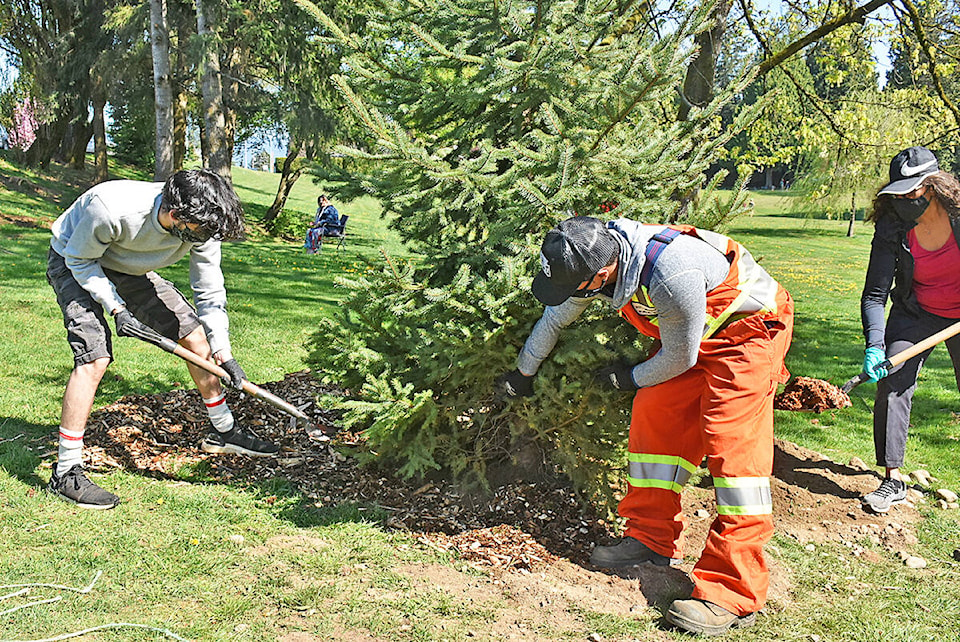Pitt Meadows needs more trees, and it needs them now.
That’s what biologist Jori Porter explained to city council at the Feb. 27 meeting as she presented the city’s first proposed Urban Forest Strategy to help combat this issue.
Through a partnership between the City of Pitt Meadows and the consulting firm McElhanny, Porter helped conduct an in-depth analysis of the city’s greenery and found a startling discovery – Pitt Meadows has a severe lack of trees.
According to the study done by McElhanney, Pitt Meadows currently contains approximately 17 per cent tree canopy cover within the Urban Containment Boundary (UCB), which accounts for the more urban core of the city and excludes most of the agricultural areas of Pitt Meadows.
Compared to numbers from 2014, this is significantly less than many surrounding communities, with Maple Ridge and Port Coquitlam having 46 per cent and 23 per cent canopy coverage within the UCB, respectively.
In fact, according to the report, Pitt Meadows was tied for the fourth-lowest amount of UCB canopy coverage among all Metro Vancouver cities in 2014, with the number of trees only slightly improving since then.
This is something that Councillor Bob Meachen called particularly upsetting for a city like Pitt Meadows.
“I was surprised and even startled when I first started seeing the report coming out,” said Meachen. “We’re not doing well at all. We pride ourselves in being the natural place and yet, we’re on the low end of the bell curve in terms of tree canopies.”
To try and counteract this problem, Porter and her team held several open-house information sessions in 2023 to gather information about what Pitt Meadows residents wanted to see happen with the local greenery.
“Overall, we had 209 survey responses, which my planning team felt was amazing,” said Porter.
The public engagement revealed that residents have noticed this lack of trees, with more than 80 per cent of people surveyed saying that they felt the current tree canopy coverage in the city was inadequate.
“We heard four main themes to the feedback,” said Porter.
“The public wanted to maintain the existing canopy coverage; place a focus on opportunities to increase canopy coverage on city and public space; emphasize the importance of environmental, mental and physical, and beautifying benefits of the urban forest; and they showed a significant interest in supporting opportunities to promote stewardship-based initiatives.”
While the proposed draft of the Urban Forest Strategy did offer some solutions for the lack of trees, Porter explained that it’s not as simple as just planting as many trees into parks and green spaces.
“Our assessment found that a lot of the land in the city is already developed,” she said. “So with the limited potential planting areas, the key is to protect the trees that are already here and hope that those can grow to a greater maturity.”
According to the report, only 38 per cent of the land within the city’s UCB was even suitable for planting without requiring significant development. And of this 38 per cent of permeable potential planting area, an overwhelming 32 per cent of it is private land.
Porter explained that in order to greatly increase the number of trees within Pitt Meadows, an estimated 60 per cent of the new plantings would need to be located on private lands instead of public areas like parks, boulevards, and school sites.
As part of the proposed plan, Porter encouraged city council to take a few key steps:
• Develop a tree protection bylaw
• Create a plan for known problem locations that have trees damaging nearby sidewalks and infrastructure
• Update the list of recommended tree species for the city to include more climate-resilient types
• Update the street tree inventory for better asset management
• Educate the community on the importance of the urban forest
• Partner with regional groups to help increase tree canopy cover on private land
• Increase public tree canopy cover
The recommended tree canopy target in the Urban Forest Strategy was to reach 30 per cent coverage by 2050, which project manager Michelle Baski said would require a lot of work.
“The 13 per cent increase in canopy cover equates to approximately 11,500 trees,” said Baski.
Between the cost of purchasing the trees and paying staff to plant them, the cost of reaching this target could potentially be quite high, warned Baski.
“On average, it’s estimated that the installation costs for a tree is approximately $800,” she said. “Then there’s about three to five years of more intensive watering and maintenance required, plus the longer but less frequent maintenance as the tree gets older.”
However, she encouraged council to look at the Urban Forest Strategy as an investment rather than just an expense thanks to the significant number of benefits offered by having a lot of trees in the city.
“The TD Economics Special Report indicates that for each dollar spent on forestry in the Greater Vancouver region, residents receive at least $4.59 in benefits each year in return in the form of stormwater management, air quality improvements, energy savings, and carbon sequestration,” said Baski.
In a unanimous vote, city council approved advancing the Urban Forest Strategy to the next step, which Baski explained would include another round of public feedback so the plan can be finalized and eventually adopted.
